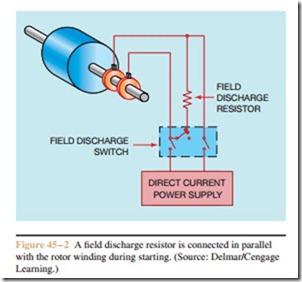Excitation Current
There are several ways in which excitation current can be supplied to the rotor of a synchronous motor, such as slip rings, a brushless exciter, and a DC generator. Small synchronous motors generally contain two slip rings on the rotor shaft. A set of brushes are used to supply direct current to the rotor (Figure 45 – 2).
If manual starting is employed, an operator will manually excite the rotor after it has accelerated close to synchronous speed. During this acceleration process, a high voltage can be induced into the windings of the rotor. A resistor, called the field discharge resistor, is connected in parallel with the rotor winding. Its function is to limit the amount of induced voltage when the motor is started and limit the amount of induced voltage caused by the collapsing magnetic field when the motor is stopped and the excitation current is disconnected. A switch called the field discharge switch is used to connect the excitation current to the rotor. The switch is so designed that when it is closed it will make connection to the direct current power supply before it breaks connection with the field discharge resistor. When the switch is opened, it will make connection to the field dis- charge resistor before it breaks connection with the direct current power supply. This permits the field dis- charge resistor to always be connected to the rotor when DC excitation is not being applied to the rotor.
